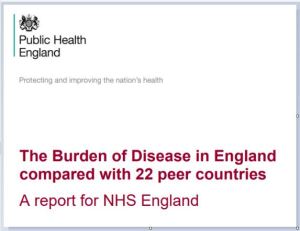There are reports of rising ill-health often attributed to the Covid epidemic and the current failure to see, let alone treat, many people with serious illnesses. Many people are unfit to work and hundreds of thousands elders are unable to care for themselves whether living at home or in one of the UK’s 17,079 care homes.
ONS figures show that the rise in long-term sickness is a trend recorded well before the Covid pandemic. Illhealth is an increasingly common reason for economic inactivity; 28% of those dropped out of the labour market in June to August 2022 as 150,000 workers joined the existing 2.5 million in the two months to the end of July.
 A Public Health England report, The Burden of Disease in England compared with 22 peer countries, presented data from 2018-2019 showing that before Covid and the escalating NHS problems, health in England alone was already poor, compared with that in 22 peer countries.
A Public Health England report, The Burden of Disease in England compared with 22 peer countries, presented data from 2018-2019 showing that before Covid and the escalating NHS problems, health in England alone was already poor, compared with that in 22 peer countries.
In that report, Public Health England (PHE), a government quango, found that the ‘top 4’ diseases have remained static over time. Alzheimer’s disease, colorectal and pancreatic cancer, and drug use disorders have increased their rank. Cardiovascular disease, cancer, non-communicable respiratory disease and injury dominate the mortality ranking:
“Compared with our peer group (22 peer countries) we rank higher for lower respiratory tract infections, neonatal mortality, oesophageal cancer and aortic aneurysm. Cardiovascular diseases incidence and prevalence in England are in the highest quartile of rates for peer countries. This is largely due to a much higher incidence and prevalence of ischaemic heart disease narrowed heart arteries . . . Amongst conditions amenable to healthcare, England performs relatively poorly for breast, cervical and colorectal cancer and epilepsy.”
Money UK (insurance assessors) lists the top 20 healthiest places in which to live
PHE adds that our Healthcare Access and Quality Index shows that our relative position has remained consistently in the lowest 25% of our peer group and for premature deaths amenable to healthcare, England is improving but remains in the bottom quartile of peer countries.
The pittance spent on prevention must be nurtured, not neglected, or NHS investment will fail to deliver the economic growth that is being promised:
 So say Deborah Arnott, Chief Executive, Action on Smoking & Health, Professor Sir Ian Gilmore (right), a former President of the Royal College of Physicians and Chair of the Alcohol Health Alliance UK and Katharine Jenner, Director, Obesity Health Alliance (FT)
So say Deborah Arnott, Chief Executive, Action on Smoking & Health, Professor Sir Ian Gilmore (right), a former President of the Royal College of Physicians and Chair of the Alcohol Health Alliance UK and Katharine Jenner, Director, Obesity Health Alliance (FT)
They point out that the evidence is clear about how to achieve the greatest impact in reducing disease, disability and premature death: prevent illness in the first place. Investment in treatment is necessary but not sufficient. The Health Foundation has estimated that public health interventions cost three to four times less than that of NHS interventions for each additional year of good health achieved in the population.
(Ed): those advocating prevention will be able to present an even stronger case by liaising with bodies exposing the health impacts of polluted air, water and the use of toxic domestic and agricultural chemicals

EN writes: Contamination of our food must be an important contributor to illness (in addition to the nutrient-poor qualilty of much of what many people eat). Agricultural pesticides enter crops and residues can remain. If the current UK Government proceeds to introduce genetically modified (GM) foods and crops into this country, there will be far more contamination of our diet. Gene-edited foods, despite the claims of safety, carry the same risks as the older GM crops plus additional dangers.